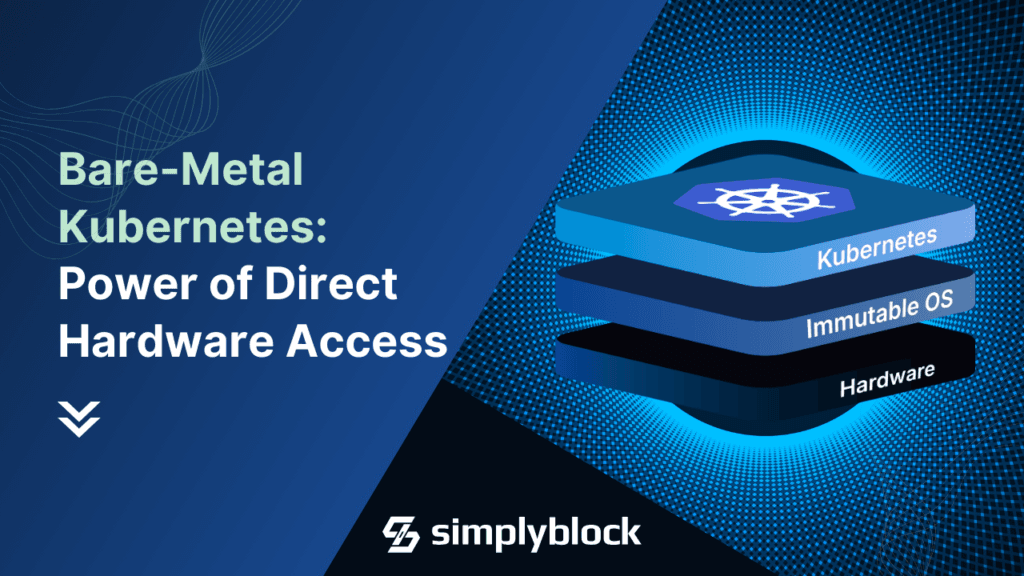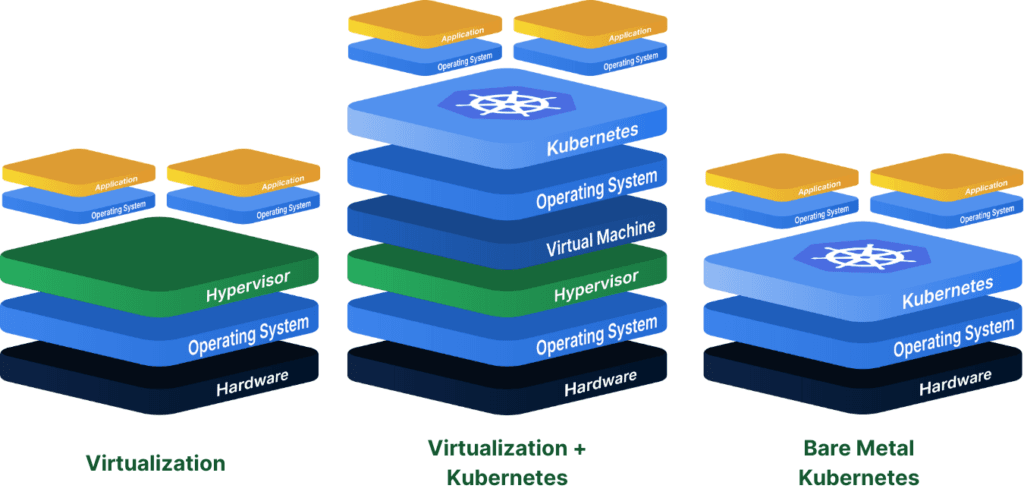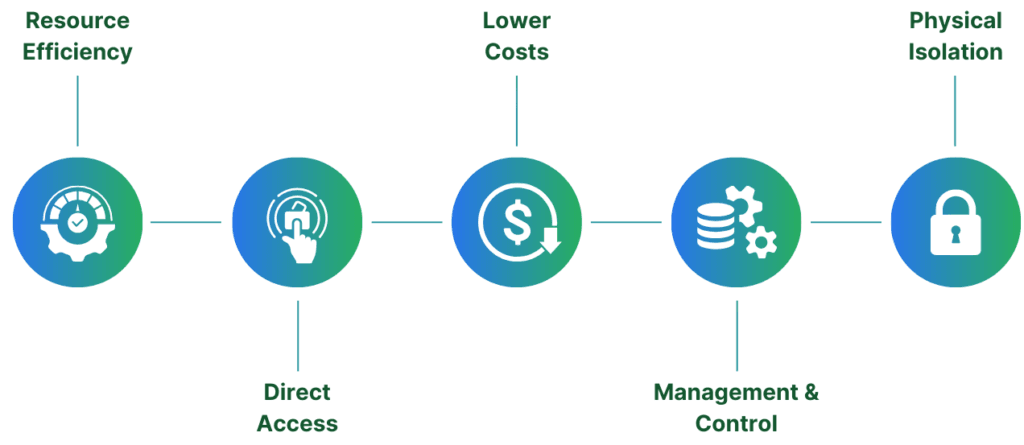
As of 2025, over 90% of enterprises have adopted Kubernetes. The technology has matured, and the ecosystem around containerization technologies is richer than ever. More platform teams are realizing the tangible benefits of running containerized workloads directly on bare-metal Kubernetes infrastructure, especially when compared to virtualized environments like VMware or OpenStack. This shift is particularly evident in storage performance, where removing virtualization layers leads to significant efficiency and speed gains.

Why Run Kubernetes on Bare Metal?
There are several compelling reasons to consider bare-metal Kubernetes deployments.
Virtualized environments like VMware and OpenStack have traditionally been used to run Kubernetes, but they introduce unnecessary overhead, especially for high-performance workloads.
By running Kubernetes on bare metal, businesses can eliminate the virtualization layer and gain direct access to hardware resources. This results in lower latency, higher throughput, and improved overall performance. It is especially beneficial for I/O-intensive applications, such as databases and real-time systems, where every microsecond of delay counts.
Moreover, the recent VMware acquisition by Broadcom has triggered many enterprises to look for alternatives, and Kubernetes has emerged as a top choice for many former VMware users.
Last but not least, bare-metal Kubernetes supports scalability without the complexity of managing virtual machines and containerized infrastructure. Containerization has revolutionized how applications are built and deployed. However, the complexity of managing containerized infrastructures alongside virtual machines has posed challenges for infrastructure teams. A complete transition to Kubernetes offers a unified approach for stateless and stateful workloads.
The Hidden Cost of Virtualization
When they came out, virtualization platforms like VMware and OpenStack were game-changers. They enabled more efficient use of hardware resources such as CPU and RAM for a small overhead cost of virtualization. However, as the adoption of containerized applications and Kubernetes grows, the inefficiencies of these platforms become more apparent.
Every layer of virtualization introduces performance overhead. Each additional abstraction between the application and the physical hardware consumes CPU cycles, adds memory overhead, and introduces latency, particularly in I/O-heavy workloads. While technologies are paravirtualization, enabling drivers inside virtual machines to bypass large parts of the OS driver stack, the overhead is still significant. However, Kubernetes (and containerization in general) is more resource-friendly than traditional hypervisor-based virtualization. Containerization doesn’t require an entire operating system per container and shares most host resources, isolating applications and physical hosts through filters and syscall guards.
From an operation perspective, managing both virtualization layers and Kubernetes orchestration platforms compounds this complexity.
Storage Performance: The Bare-Metal Advantage
One of the key differentiators for bare-metal Kubernetes is its ability to maximize storage performance by eliminating these virtualization layers. Direct hardware access allows NVMe devices to connect directly to containers without complex passthrough configurations. This results in dramatically lower latency and enhanced IOPS. This direct mapping of physical to logical storage resources streamlines the data path and increases performance, particularly for I/O-intensive applications like databases.
Consider a typical storage path in a virtualized environment:
Application → Container → Kubernetes → Virtual Machine → Hypervisor → Physical Storage
Now, compare it to a bare metal environment:
Application → Container → Kubernetes → Physical Storage
By reducing unnecessary layers, organizations see substantial improvements in both latency and throughput, making bare-metal Kubernetes ideal for high-demand environments.

Figure 1: Comparison of system layers for storage access with normal virtualization, virtualization and Kubernetes, and bare metal Kubernetes
NVMe/TCP: The Networking Revolution for Bare-Metal Kubernetes
For bare-metal Kubernetes deployments, the storage performance benefits are further enhanced with NVMe-over-Fabrics (NVMe-oF). Specifically using NVMe/TCP, the successor to iSCSI. This enables organizations to leverage high-speed networking protocols, allowing storage devices to communicate with Kubernetes clusters over a network, providing enterprise-grade performance and scalability. Best of all, NVMe/TCP eliminates the traditional limitations of local storage (physical space limitations) or Fibre Channel and Infiniband solutions (requirement for specialized network hardware).
Simplyblock is built to optimize storage performance in Kubernetes environments using NVMe-oF and NVMe/TCP. Our architecture allows Kubernetes clusters to efficiently scale and use networked NVMe storage devices without sacrificing the low-latency, high-throughput characteristics of direct hardware access.
By integrating NVMe/TCP, simplyblock ensures that storage access, whether local or over the network, remains consistent and fast, allowing for seamless storage expansion as your Kubernetes environment grows. Whether you’re managing databases, real-time analytics, or microservices, NVMe/TCP provides the robust networking backbone that complements the high-performance nature of bare-metal Kubernetes.
Bridging the Gap with Modern Storage Solutions
While the performance benefits of bare metal deployments are clear, enterprises still require advanced storage capabilities. An enterprise-grade storage solution requires high availability, data protection, and efficient resource utilization without sacrificing scalability. Solutions like simplyblock meet these needs without the added complexity of virtualization.
Simplyblock’s NVMe-first architecture directly integrates into Kubernetes environments, providing user-space access to NVMe devices at scale. Simplyblock simplifies persistent volume provisioning with enterprise features such as instant snapshots, clones, and transparent encryption— all without compromising performance.
Discover how Simplyblock optimizes Kubernetes storage.
Future-Proofing Infrastructure with Bare Metal
With advancements in storage and networking technologies, the advantages of bare-metal Kubernetes continue to grow. New NVMe devices are pushing the performance limits, demanding direct hardware access. On the other hand, innovations such as SmartNICs and DPUs require tight integration with the hardware.
In addition, all modern microservices architectures, real-time applications, and high-performance databases benefit from the predictability and low-latency performance offered by bare-metal. It was always something virtualization struggles to deliver.

The Cost Equation
We’ve talked a lot about performance benefits, but that’s not the only reason you should consider adopting bare-metal Kubernetes infrastructures. Kubernetes equally helps to achieve optimal hardware utilization while controlling costs.
Removing the virtualization layer reduces infrastructure and licensing costs, while the streamlined architecture lowers operational overhead. Solutions like simplyblock enable organizations to achieve these financial benefits while maintaining enterprise-grade features like high availability and advanced data protection. The benefits of running on a standard Ethernet network stack and using NVMe over TCP further add to the cost benefits.
Nevertheless, transitioning to bare-metal Kubernetes is not an all-or-nothing process. First, enterprises can begin with I/O-intensive workloads that would benefit the most from performance gains and gradually scale over time. With many Kubernetes operators for databases available, running databases on Kubernetes has never been easier.
Second, enterprises can keep specific applications that may not run well on containers in virtual machines. Kubernetes extensions, such as KubeVirt, help manage virtual machine resources using the same API as containers, simplifying the deployment architecture.
That further confirms the growing adoption of stateful workloads on Kubernetes.
The Future of Kubernetes is Bare Metal
Organizations need infrastructure that taps directly into hardware capabilities while offering robust enterprise features to remain competitive in today’s fast-moving and cloud-native landscape. Bare-metal Kubernetes, combined with cutting-edge storage solutions like simplyblock, represents the ideal balance of performance, scalability, and functionality.
Ready to optimize your Kubernetes deployment with bare-metal storage and networked NVMe solutions? Contact Simplyblock today to learn how our solutions can drive your infrastructure’s performance and reduce your costs.
Questions and Answers
Bare-metal Kubernetes refers to running Kubernetes directly on physical servers without a virtualization layer. It offers better performance, lower latency, and more control over hardware resources, making it ideal for demanding workloads like databases and AI pipelines.
Unlike managed environments, bare-metal lacks built-in dynamic provisioning and elastic block storage. That’s why integrating a high-performance, CSI-compliant solution like Simplyblock’s NVMe-over-TCP storage is critical for reliability and speed.
To support stateful apps like PostgreSQL or MongoDB, your storage must be fast, persistent, and support dynamic volume provisioning. Simplyblock enables this through Kubernetes-native storage that’s optimized for databases on Kubernetes.
Absolutely. NVMe over TCP offers high IOPS and low latency without needing proprietary fabrics. It brings the performance of local NVMe to a distributed Kubernetes environment, making it ideal for bare-metal setups.
For on-prem clusters, you need a flexible, scalable solution that avoids vendor lock-in. A software-defined storage platform like simplyblock provides dynamic provisioning, snapshots, and encryption—purpose-built for bare-metal Kubernetes.
